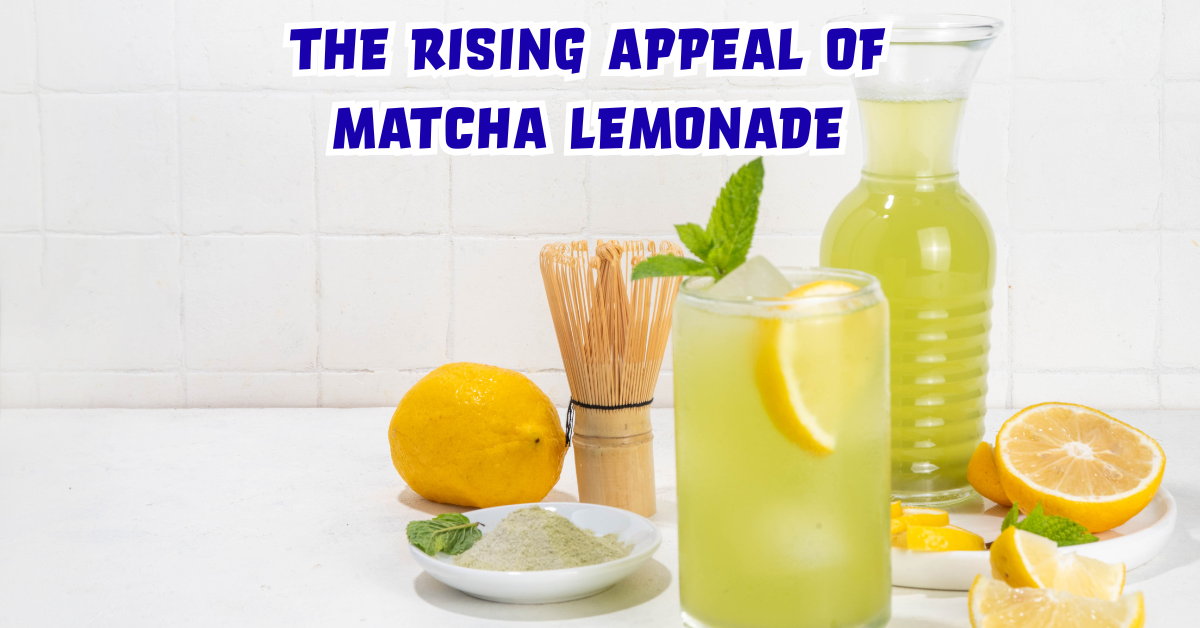In the ever-evolving landscape of wellness beverages, matcha lemonade has quietly yet powerfully emerged as a global favorite. Within just a few years, what began as an artisanal café experiment has evolved into a lifestyle statement—one that embodies the harmony between rejuvenation and relaxation.
For the curious drinker searching for something that awakens the mind without overwhelming the senses, matcha lemonade offers exactly that balance. It merges the earthy depth of premium matcha with the zesty brightness of freshly squeezed lemons. The result is a drink that feels both ancient and new—rooted in Japanese tea culture yet perfectly attuned to modern health trends.
In this article, we’ll explore every layer of this fascinating drink: from its origins and health benefits to preparation techniques, modern variations, and its role in today’s wellness movement.
The Origins of Matcha Lemonade
While matcha has been consumed in Japan for centuries as part of Zen Buddhist traditions, its introduction to Western beverage culture is relatively recent. Historically, monks drank matcha before meditation sessions to enhance focus and calm—two qualities that now attract modern professionals seeking mindfulness in a cup.
Lemonade, on the other hand, traces its lineage to Middle Eastern and Mediterranean origins, long valued for its refreshing and revitalizing qualities. When these two elements met in cafés experimenting with healthier alternatives to sugary sodas, matcha lemonade was born—a union of calm and vitality.
It wasn’t a planned trend; it was a cultural meeting point. Western fascination with matcha’s “clean energy” paired with the universal love for lemonade’s tangy sweetness created a drink that fits neatly into the rhythm of contemporary life.
Understanding Matcha: The Green Heart of the Drink
Before diving into the beverage itself, it’s essential to understand what makes matcha so distinct. Unlike traditional green tea, matcha involves consuming the whole leaf—ground into a fine, vibrant green powder. This means that every sip delivers higher concentrations of antioxidants, amino acids, and nutrients.
| Nutrient | Primary Benefit | Matcha Concentration (Compared to Regular Green Tea) |
|---|---|---|
| Catechins (EGCG) | Fights free radicals and supports heart health | Up to 137x more |
| L-Theanine | Promotes calm alertness | 5x higher |
| Chlorophyll | Detoxifies and boosts skin health | Richly concentrated |
| Caffeine | Provides smooth, sustained energy | Balanced, longer-lasting release |
The synergy between caffeine and L-Theanine in matcha is particularly fascinating—it energizes the body while calming the mind, avoiding the jittery crash associated with coffee.
When combined with the vitamin C and acidity of lemon juice, these compounds become even more bioavailable, enhancing absorption and overall effect.
The Science Behind the Matcha-Lemon Synergy
The pairing of matcha and lemon isn’t just about taste—it’s about chemistry. Lemon juice’s acidic profile enhances the absorption of catechins, the potent antioxidants found in matcha. These catechins, especially EGCG (epigallocatechin gallate), have been linked to improved metabolism, anti-inflammatory effects, and cellular protection.
In essence, adding lemon to matcha doesn’t just make it tastier—it amplifies its benefits.
Moreover, the vitamin C in lemon stabilizes the delicate compounds in matcha that can otherwise degrade quickly when exposed to light or air. This means your drink stays potent and effective longer—a hidden advantage for health enthusiasts.
The Modern Popularity of Matcha Lemonade
Matcha lemonade represents more than just a beverage—it’s a cultural reflection of our times. In a world that moves fast and demands balance, this drink offers a microcosm of wellness and awareness.
- For the fitness-minded, it’s a natural pre-workout energizer that hydrates without artificial additives.
- For professionals, it’s a focus-enhancing beverage that replaces the mid-day coffee crash.
- For the wellness-conscious, it’s a low-sugar, antioxidant-rich indulgence that aligns with mindful living.
The appeal has also spread across social media platforms, with visually captivating swirls of green and yellow becoming a favorite aesthetic among health influencers and food stylists.
How to Make Matcha Lemonade at Home
Crafting the perfect matcha lemonade at home is as much about technique as it is about ingredients. Below is a professional yet approachable method for achieving café-quality results.
| Ingredients | Quantity | Purpose |
|---|---|---|
| Ceremonial-grade matcha powder | 1 tsp | Provides depth, color, and energy |
| Hot water (not boiling) | 2 oz | Dissolves matcha evenly |
| Freshly squeezed lemon juice | 2 tbsp | Adds tartness and vitamin C |
| Cold filtered water | 8 oz | Dilutes for refreshment |
| Honey or agave (optional) | 1 tsp | Balances acidity |
| Ice cubes | As needed | Enhances chill and texture |
Preparation Steps:
- Whisk the Matcha – In a bowl, whisk matcha with hot water using a bamboo whisk until frothy and lump-free.
- Prepare Lemon Base – In a glass, mix lemon juice with sweetener and cold water.
- Combine – Pour the whisked matcha over the lemon mixture, stirring gently.
- Serve with Ice – Add ice cubes for a cooling effect, and garnish with a lemon slice or mint leaf.
This simple process hides a beautiful duality—the ritual calm of whisking matcha meets the playful zest of lemonade-making.
Nutritional Value and Health Impact
Let’s break down what a typical serving of matcha lemonade (around 300ml) provides:
| Nutrient | Amount per Serving | Health Benefit |
|---|---|---|
| Calories | 25–40 | Low-calorie refreshment |
| Vitamin C | 30–35mg | Immune support |
| Antioxidants (EGCG) | 60–80mg | Fights oxidative stress |
| L-Theanine | 20–25mg | Promotes relaxation and focus |
| Caffeine | 30–35mg | Gentle, sustained energy |
Together, these elements create a drink that doesn’t just quench thirst but supports the body’s rhythm—energizing in the morning, soothing in the afternoon.
Why Matcha Lemonade is More Than Just a Summer Drink
Unlike traditional lemonade, which often peaks during warm months, matcha lemonade maintains appeal year-round. In colder weather, it can be served warm—transforming into a comforting elixir that soothes the throat and mind.
It also adapts beautifully to personal preference: some enjoy it tart and pure, others layer it with fruit infusions like mint, ginger, or cucumber. Cafés have even started introducing sparkling matcha lemonade, merging natural wellness with effervescent delight.
Matcha Lemonade in Modern Cafés
Today’s cafés view matcha lemonade as more than a menu item—it’s a branding tool. The drink’s color gradient, from luminous green to golden yellow, has made it a visual centerpiece. It appeals to customers who value authenticity but also want Instagram-worthy aesthetics.
Baristas have developed creative variations:
- Lavender Matcha Lemonade – Adds floral calmness.
- Ginger Matcha Lemonade – Boosts immunity and warmth.
- Coconut Matcha Lemonade – Introduces tropical richness.
The drink’s flexibility allows cafés to stay innovative while promoting health-focused alternatives to traditional caffeine drinks.
Sustainability and the Matcha Movement
Beyond taste and health, the rise of matcha lemonade intersects with growing awareness about sustainability. High-quality matcha is shade-grown, a practice that preserves soil integrity and biodiversity. Lemon cultivation, when sourced locally, further reduces carbon footprints.
Consumers now seek beverages that align with ethical production and environmental consciousness. The green hue of matcha has become symbolic—not just of vitality but of eco-responsibility.
The Psychological Impact: A Drink That Feels Good
Interestingly, many drinkers describe matcha lemonade as emotionally uplifting. There’s a psychology behind this experience. The drink’s bright color palette subconsciously evokes freshness and positivity, while its aroma of earth and citrus provides sensory balance.
Moreover, the gentle caffeine release combined with L-Theanine contributes to mood regulation—providing alertness without agitation. In an age marked by stress and overstimulation, this subtle balance is a quiet luxury.
Common Mistakes When Making Matcha Lemonade
Even though the recipe is simple, several factors can impact the quality of your drink:
| Mistake | Effect | Correction |
|---|---|---|
| Using boiling water | Burns matcha, making it bitter | Use water at 75–80°C |
| Skipping the whisking step | Causes clumps and uneven flavor | Always whisk matcha properly |
| Using bottled lemon juice | Dulls freshness and flavor | Use freshly squeezed lemons |
| Adding too much sweetener | Overpowers matcha’s natural depth | Add sweetness gradually |
| Using low-quality matcha | Results in dull color and taste | Invest in ceremonial-grade matcha |
Attention to these details elevates your drink from good to exceptional.
The Economics of Matcha Lemonade
Interestingly, the commercial appeal of matcha lemonade extends into the business realm. Cafés and restaurants have found that its perceived health value justifies premium pricing. Consumers are willing to pay more for a drink that aligns with wellness, sustainability, and aesthetic pleasure.
In markets like the UK, USA, and Japan, it’s become a symbol of “conscious luxury”—affordable yet meaningful indulgence.
Cultural Crossroads: East Meets West
At its core, matcha lemonade represents cultural synthesis. It embodies Japanese mindfulness and Western zest. This intersection has become one of the most defining aspects of global food culture—where respect for tradition meets the curiosity of innovation.
The drink bridges rituals from Japanese tea ceremonies and Western refreshment traditions, offering a daily reminder that wellness can be both ancient and new.
Future Trends: What’s Next for Matcha Lemonade
Looking ahead, matcha lemonade is evolving beyond cafés. Ready-to-drink bottled versions, sugar-free formulations, and even powdered home kits are now gaining traction. Brands are experimenting with adaptogens, probiotics, and collagen infusions to meet niche wellness needs.
Expect to see matcha lemonade mocktails at restaurants, functional energy shots in gyms, and DIY matcha kits in lifestyle stores. The future of this beverage is not just about taste—it’s about identity, mindfulness, and sustainable indulgence.
Conclusion
Matcha lemonade has transcended its status as a trend to become a lasting symbol of mindful refreshment. It is a celebration of contrasts: ancient yet modern, energizing yet calming, simple yet sophisticated.
Each sip embodies a philosophy—balance in chaos, focus in movement, wellness in indulgence. Whether you’re whisking it at home or ordering it at your favorite café, matcha lemonade reminds us that small rituals can bring large doses of clarity.
It’s more than a drink; it’s a gentle revolution in a cup.
FAQs
1. What makes matcha lemonade healthier than regular lemonade?
Matcha lemonade contains antioxidants, L-Theanine, and vitamin C, making it more nourishing than traditional sugar-heavy lemonade.
2. Can I use culinary-grade matcha for lemonade?
Yes, but ceremonial-grade matcha provides smoother flavor and brighter color, ideal for cold beverages like lemonade.
3. Is matcha lemonade safe for children?
In small amounts, yes. However, it contains caffeine, so moderation is recommended for younger drinkers.
4. Can matcha lemonade help with weight management?
Its EGCG content may boost metabolism and fat oxidation, making it a beneficial addition to a balanced diet.
5. How long can matcha lemonade be stored?
It’s best consumed fresh, but when refrigerated in an airtight container, it can stay flavorful for up to 24 hours.











